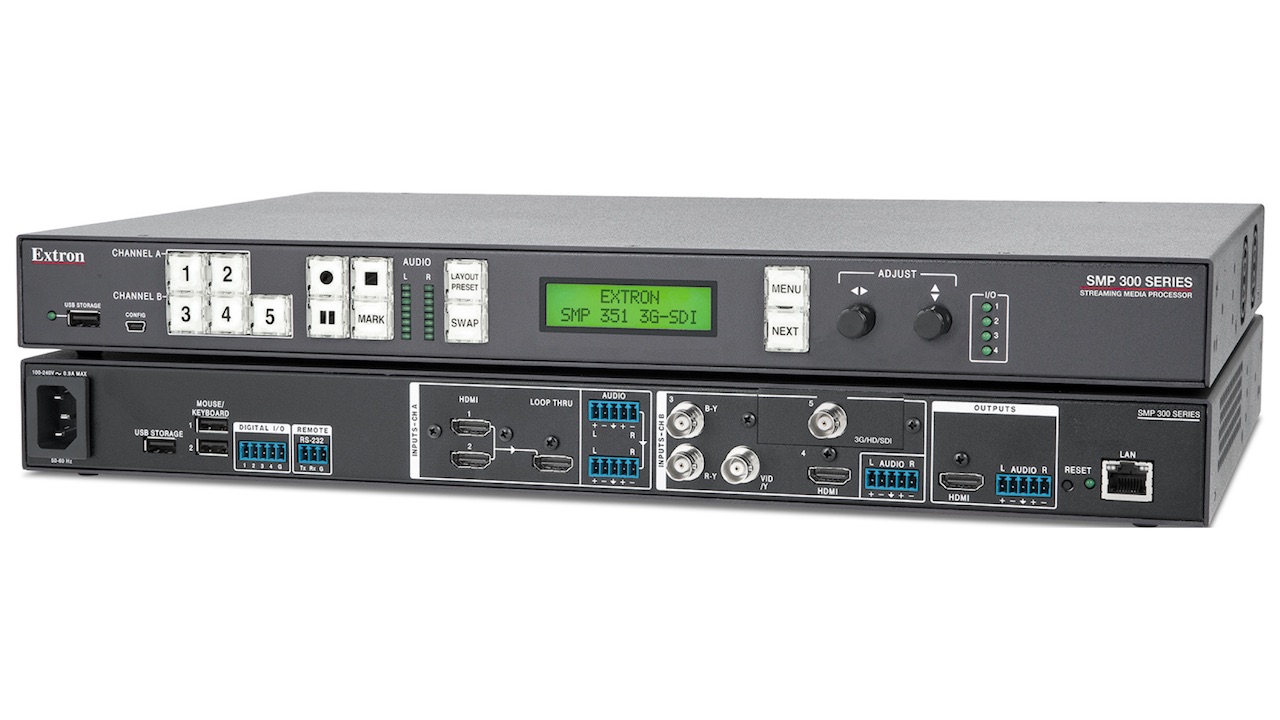Lecture capture for online education was already skyrocketing in importance over the past few years. Now, it’s now become essential for all institutions. To help facilitate this, Extron developed the SMP 351, a high-performance recording and streaming processor for capturing and distributing AV sources and presentations. Designed for simple control and flexibility, it’s able to record and stream simultaneously and can stream at two different resolutions and bitrates concurrently using a range of transport protocols and session management options. So just how intuitive and powerful is it?
Capabilities
A primary reason to have this unit is, of course, to record. There are plenty of options available in this system. It allows you to record to an internal hard drive, has multiple connections for USB drives, can save to a network share, and can send the information over a single- or dual-RTMP stream, which can be used in a number of ways. The SMP can be integrated into Kaltura, Panopto, and Opencast for content publishing and live streams, and it can publish live streams directly to Facebook Live, YouTube, Wowza, Twich, and others via RTMP. The system even allows for dual recording, so you can set up an automatic archive. This is very helpful for livestreamed productions that will later be edited for time and content and uploaded. Plus, it’s good just to have the raw footage available.
You can’t be too careful when it comes to capturing important events, and this system has a lot of failover options. You can easily set up backup streams, secondary recordings, and failover recording locations. According to the user manual, it can support a maximum of two encodes, one local output, one recording, and livestreaming simultaneously, and we were able to replicate that with ease. It can also be configured to record in two locations at once and livestream along with many other configurations. The versatility and ease of setup is second to none.
Configuration
When it comes time to set up a recording, the system has a built-in calendar so you can automate the process by scheduling a start time. The unit supports iCal feeds, Google Calendar, and Microsoft Office 365/Exchange scheduling, as well as scheduling with the company’s integration with both Kaltura and Panopto. It also supports Kaltura and Opencast APIs, which can be used to streamline the process even more.
If you have any problems getting things started, the system has a great toolset for configuration as well as for troubleshooting. Image formatting and color correction can be performed on each input independently. It’s easy to fine tune all of the inputs through a single location, and statistics about the incoming signals are available in multiple locations. If you are having connection issues, you can ping, tracert, or Nmap directly from the interface. This is very handy when trying to iron out network connection troubles.
Setting up a confidence monitor is easy: simply plug it in and the presenter can preview exactly what is being sent to the recorder. There are several preset layouts available along with the ability to design a custom layout, choose background images, metadata location, and configure the window size and layout.
Operation
We conducted some testing with Extron SMD 202 decoders that the company supplied to simulate content sources. (In a real-world scenario, users would typically connect computer sources, cameras, document cameras, and the like.) The SMD decoders are fan-less and produce no noise, a beneficial attribute when the SMP and source decoders are installed within a lectern or near students in a room. (The decoders or other main switching and source units they connect to do have fans, but those can be easily moved away into a network closet. The ability to professionally rack-mount these products is also a plus. We are often surprised when supposedly “professional” AV equipment, specifically recording equipment, is not rack mountable.) Surprisingly, audio processing is more than simple gain control. It also has tone adjustment, compression, and a section for ducking.
In our test, the SMP 352 proved to be highly versatile for recording. The user interface is great, and it is easy to understand while providing advanced features. We were impressed by the amount of control available to format signals, as well as the options to save data. You can set up custom overscan or even custom-sample the signal to improve quality for scaling. After you get everything tuned exactly the way you want it, save it as a preset and you can apply it to other inputs if they require similar settings or have presets for various lighting concerns.
Concerns
Potential buyers of this product should be aware that while it does have video switching, the primary function of the device is to record and stream and not to be a production video switcher—thus, there are no features like transitions, chromakey/lumakey/transparency, or echo canceling and noise reduction. The switching is a little on the slower side, but it’s not designed as a seamless production switcher, so this isn’t an issue in most applications for which the device is intended. Video input and encoding is only supported up to 1080p30 (the unit accepts 1080p60 signals), but for the majority of lecture capture scenarios, that’s fine. It does however let you adjust the GOP length, so you can balance how much bandwidth is consumed with optimum image quality.
Conclusion
In summary, this is a great option for anyone looking to make recordings of their streaming video. It provides a nice balance of power and intuitiveness, and has a wide array of features that provide all the tools needed without feeling cluttered. This would be ideal for use in corporate, education, government, healthcare, courtrooms, houses of worship, rental and staging, and many other applications.

